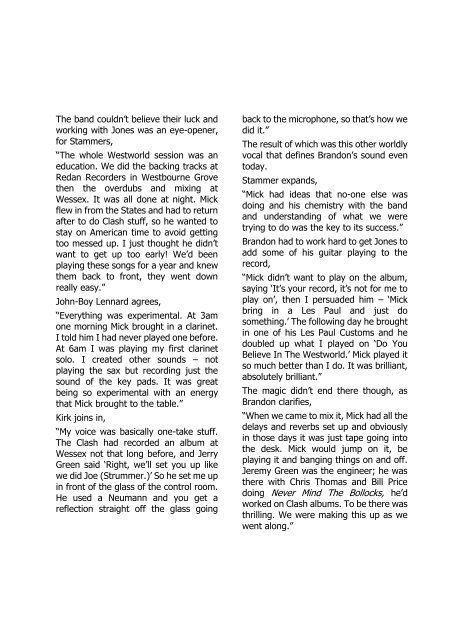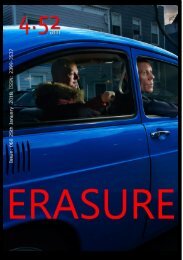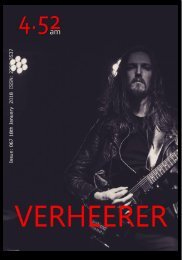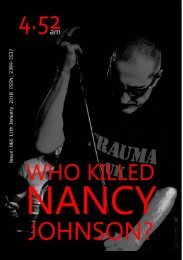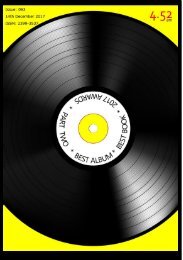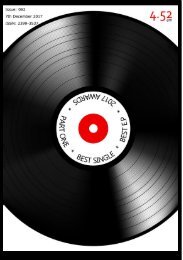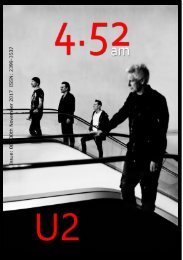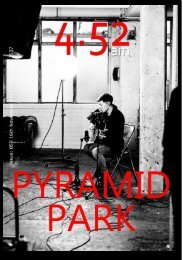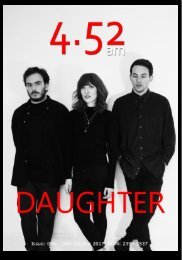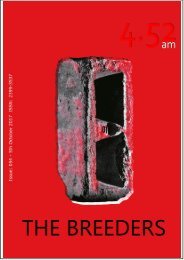4.52am Issue: 016 - 8th January 2017
Your Free Weekly Guitar and Alternative Music Magazine from Guitar Quarterly
Your Free Weekly Guitar and Alternative Music Magazine from Guitar Quarterly
You also want an ePaper? Increase the reach of your titles
YUMPU automatically turns print PDFs into web optimized ePapers that Google loves.
The band couldn’t believe their luck and<br />
working with Jones was an eye-opener,<br />
for Stammers,<br />
“The whole Westworld session was an<br />
education. We did the backing tracks at<br />
Redan Recorders in Westbourne Grove<br />
then the overdubs and mixing at<br />
Wessex. It was all done at night. Mick<br />
flew in from the States and had to return<br />
after to do Clash stuff, so he wanted to<br />
stay on American time to avoid getting<br />
too messed up. I just thought he didn’t<br />
want to get up too early! We’d been<br />
playing these songs for a year and knew<br />
them back to front, they went down<br />
really easy.”<br />
John-Boy Lennard agrees,<br />
“Everything was experimental. At 3am<br />
one morning Mick brought in a clarinet.<br />
I told him I had never played one before.<br />
At 6am I was playing my first clarinet<br />
solo. I created other sounds – not<br />
playing the sax but recording just the<br />
sound of the key pads. It was great<br />
being so experimental with an energy<br />
that Mick brought to the table.”<br />
Kirk joins in,<br />
“My voice was basically one-take stuff.<br />
The Clash had recorded an album at<br />
Wessex not that long before, and Jerry<br />
Green said ‘Right, we’ll set you up like<br />
we did Joe (Strummer.)’ So he set me up<br />
in front of the glass of the control room.<br />
He used a Neumann and you get a<br />
reflection straight off the glass going<br />
back to the microphone, so that’s how we<br />
did it.”<br />
The result of which was this other worldly<br />
vocal that defines Brandon’s sound even<br />
today.<br />
Stammer expands,<br />
“Mick had ideas that no-one else was<br />
doing and his chemistry with the band<br />
and understanding of what we were<br />
trying to do was the key to its success.”<br />
Brandon had to work hard to get Jones to<br />
add some of his guitar playing to the<br />
record,<br />
“Mick didn’t want to play on the album,<br />
saying ‘It’s your record, it’s not for me to<br />
play on’, then I persuaded him – ‘Mick<br />
bring in a Les Paul and just do<br />
something.’ The following day he brought<br />
in one of his Les Paul Customs and he<br />
doubled up what I played on ‘Do You<br />
Believe In The Westworld.’ Mick played it<br />
so much better than I do. It was brilliant,<br />
absolutely brilliant.”<br />
The magic didn’t end there though, as<br />
Brandon clarifies,<br />
“When we came to mix it, Mick had all the<br />
delays and reverbs set up and obviously<br />
in those days it was just tape going into<br />
the desk. Mick would jump on it, be<br />
playing it and banging things on and off.<br />
Jeremy Green was the engineer; he was<br />
there with Chris Thomas and Bill Price<br />
doing Never Mind The Bollocks, he’d<br />
worked on Clash albums. To be there was<br />
thrilling. We were making this up as we<br />
went along.”


